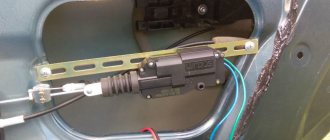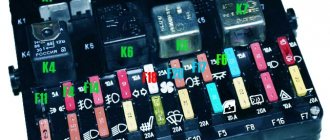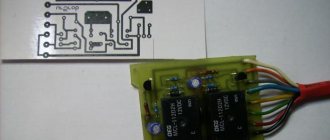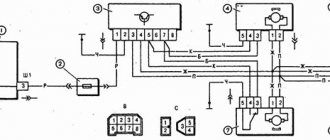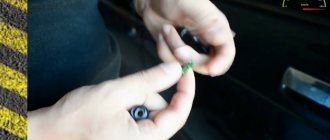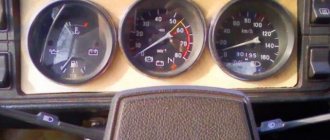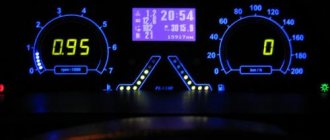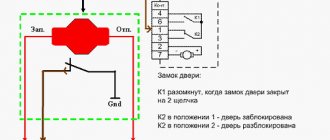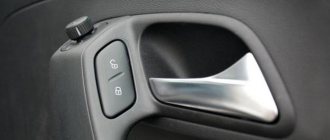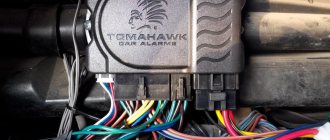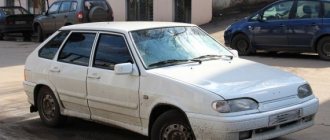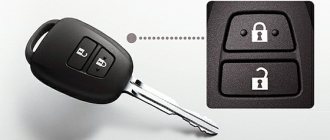The presence of a central locking system in the VAZ-2114 and other models of this generation is an excellent help in operating a car, because the central lock not only adds comfort, but also guarantees that all doors are accurately locked.
Another thing is that this system on domestic cars often malfunctions, or even breaks down completely - for example, after closing the driver’s door, the rest remain unlocked.
For some time, a slight movement of the key in the well may help, but not immediately, but the central locking works, but you can’t drive for a long time with such a breakdown, so as not to risk it.
When trying to independently find the reason why the door on a VAZ-2114 does not close, it is worth taking a closer look at the main lock drive: this unit often causes trouble due to problems with contact closure.
The lock itself works according to the following scheme:
- an electric drive is installed in the driver's door;
- the drive controls both the driver's door lock and the signal to the central locking unit;
- The lock block issues directed signals to the drive of other doors.
In order for the driver's drive to perform this task, it is equipped with five plugs: the central unit, based on the voltage in the contacts of a particular door, gives commands to open or lock, focusing on the driver's door.
The problem may be that the adjusted "lock button - electric drive" circuit is broken: the button moves down enough to mechanically close the driver's door, but does not close the contacts of the drive. Accordingly, a lack of a couple of millimeters leads to the fact that the central lock does not receive a signal to block the remaining doors.
To eliminate the breakdown, you just need to reduce the friction density of the button inside the casing, freeing up its movement, or adjust the mechanical traction from the button to the electric drive.
Signs of trouble
Why does the VAZ 2114 heater fan not work
? The occurrence of any malfunction in the operation of the central car lock instantly manifests itself in the form of a violation of its functionality. In this case, the signs or symptoms of a breakdown correspond to what exactly happened to the system. Therefore, problems can be identified by the following nuances:
- it is not possible to open the car using the key fob;
- opening does not work when using the key;
- the key fob does not lock the car;
- the key or button does not work when closing the door;
- one of the doors does not open or does not open;
- The central locking is triggered, closes everything, but immediately opens without a corresponding command from the driver;
- locking and unlocking work spontaneously.
We can say that malfunctions manifest themselves in the form of incorrect operation of the system. The central locking system is a complex device that consists of a large number of components and control units. This is a whole network of electrical wires, which sometimes covers the entire car. Given the complexity of the system, consideration should be given to who will carry out the repairs. It is often recommended to entrust this to specialists. At the same time, every motorist has the right and opportunity to know what malfunctions occur with the central locking, what is their cause and how they can be dealt with. Whether to repair it yourself or trust the experts is a purely individual question.
What can happen to the lock - the seven most common breakdowns
Why did the central lock installed on the VAZ-2114 stop functioning normally? For the most part, failures occur in very wet weather or due to sudden temperature changes.
Signs of impending problems include:
- jamming;
- partial (or fuzzy) operation;
- Too loud clanging and noise from the gearbox.
First of all, failures occur due to the failure of the electromagnetic relay that controls the central locking power supply. It’s not difficult to make sure that it’s the culprit – it’s enough to install a known good one in its place.
Other problems with central locking and self-check of the system
VAZ 2110 reverse light does not work
In the case where the lock was installed at the factory, for the time being it worked flawlessly, but suddenly a failure occurred, you will have to check the entire system. You can do this yourself, for which you will have to check almost all possible options - from fuses to the performance of final actuators.
Checking fuses
In case of any problems, the check should begin with the fuse box - often one of them becomes the culprit. If a fuse on one circuit systematically blows, it must be checked especially carefully, especially the condition of the activator - perhaps it is this that causes the short circuit. How to find fuses can be seen in the video:
Checking the electrical wiring
Attention! When the central locking does not work, checking the wiring is, although time-consuming, but necessary.
It should start from the entrance points to the doors, because it is in these places that the wires often break off or short out due to wear and tear of the insulation. The supply of electricity should also be checked. To do this, the wires are disconnected from the activator, and the “closed” mode is activated by the remote control. Voltage should appear on the supply wire. When you press the button that opens the lock, power should flow to another wire. Each activator is checked in this way.
Checking actuators
When the central lock does not open one door or there are periodic failures to operate, the activator itself may be the cause. If it operates on the basis of an electric motor, under certain conditions its winding may burn out or the gear that ensures the translational movement of the rod may wear out. Repairing this part is impractical; it is easier and faster to install a new activator.
Advice! There is also a situation where the central locking does not work after removing the battery. It is worth understanding that this system does not work without a battery, and it is highly undesirable to de-energize it. This may lead to a malfunction of the control unit and the need for its subsequent repair or replacement.
- How to install an alarm on a Priora
- Alarm Leopard: user manual
- How to connect and disable the standard alarm on a Priora
- What are car locks for and how are they used?
Electrical diagram of VAZ-2115-01
Years of production 2115: 1997—2012. This is a circuit with a regular button for rear fog lights (with locking), a fluorescent interior light, a connector for the clock and an 8-pin connector for the injector wiring.
1 — block headlights; 2 — fog lights; 3 — air temperature sensor; 4 - generator; 5 — electric motor of the engine cooling system fan; 6 — fan motor activation sensor; 7 — engine compartment lamp switch; 8 — block for connection to a single-wire type audio signal; 9 — sound signal; 10 — oil level sensor; 11 — front brake pad wear sensors; 12 — washer fluid level sensor; 13 — spark plugs; 14 — ignition distributor sensor; 15 - switch; 16 — carburetor solenoid valve control unit; 17 — carburetor solenoid valve; 18 — carburetor limit switch; 19 — speed sensor; 20 - starter; 21 - battery; 22 — relay for turning on fog lights; 23 — coolant level sensor; 24 — brake fluid level sensor; 25 — reverse light switch; 26 — coolant temperature indicator sensor; 27 — engine compartment lamp; 28 — windshield wiper gearmotor; 29 — oil pressure warning lamp sensor; 30 — block for connecting to the rear window washer electric motor; 31 — electric motor for windshield washer; 32 — ignition coil; 33 — instrument cluster; 34 — mounting block; 35 — brake light switch; 36 — blocks connected to the injection system wiring harness; 37 — ignition switch unloading relay; 38 — ignition switch; 39 — glove box lighting lamp; 40 — switch for the glove compartment lighting lamp; 41 — rear window heating switch; 42 — fog light switch; 43 — fog light switch; 44 — external lighting switch; 45 — alarm switch; 46 — steering column switch; 47 — instrument lighting regulator; 48 — hydraulic corrector scale illumination lamp; 49 — socket for a portable lamp; 50 — side direction indicators; 51 — switches in the front door pillars; 52 — lamp for individual interior lighting; 53 — electric heater fan; 54 — additional resistor of the electric heater fan; 55 — heater electric fan switch; 56 — backlight lamp for the electric heater fan switch; 57 — backlight lamp for heater control levers; 58 — display unit of the on-board control system; 59 — trip computer; 60 — switches in the rear door pillars; 61 — block for connection to the clock; 62 — electric fuel pump with fuel level sensor; 63 — ashtray lighting lamp; 64 — cigarette lighter; 65 — trunk lighting; 66 — trunk light switch; 67 — interior lamp; 68 — parking brake warning lamp switch; 69 — external rear lights; 70 — internal rear lights; 71 — plugs for connecting to the rear window heating element; 72 — license plate lights; 73 - additional brake signal.
See the complete diagram in one file below (click to enlarge):
Circuit 2115 with “high” panel 21083 is similar to circuit 21099 (except for the rear harness).
Where is the central locking fuse on a VAZ 2114?
Auto-help Why the fuel pump on a VAZ 2110 does not work
Central locking, or “CZ” as it is briefly called, is a necessary and essential thing for any car, allowing the owner to open and close any door in the car with just one movement of the hand. However, it happens that this system ceases to function completely, or its individual parts do not work properly.
There are reasons why one or another part of the central lock may fail, and we will discuss each in detail below.
The central locking does not work: signs of malfunction and causes of their occurrence
It happens that when the central lock located on the driver's door is closed, no action occurs on the other doors. However, as soon as you move it a little, the doors immediately closed. It is immediately clear that the problem here is the presence of malfunctions in the central locking and several reasons contribute to this.
Among all the possible causes of malfunctions, all the most basic ones can be identified.
No contact in the drive
With such a malfunction, the contacts inside the control drive do not close the necessary contacts in time. This happens for several reasons:
When such problems occur in the operation of the central locking, first of all you need to make sure that the button is lowered to the very end. If for some reason this does not happen, first inspect the casing for burrs, and then inspect the rod for its even and accurate position.
Fuse blown
If manipulations with the central locking rod do not bring any results, and they do not react in any way to either opening or locking, then first of all you need to check its electrical circuit, and specifically the fuse. Because on the central lock it can fail not only if a short circuit occurs in the circuit, but also if the slightest overload occurs.
The central locking fuse is indicated by a marker.
Overload occurs most often from insufficient position of the rods, as well as lubrication in them during winter operation of the car.
The central locking wires are broken
Broken wires are not the main reason, but one of the reasons for the failure of the central locking system. The main reason for this is the break in the wires in those places where they bear the greatest load. Such a place is definitely the passage of the corrugation from the side of the pillar and the driver's door. And since it is the driver’s door that is most often opened in any car, it receives most of the load.
- It is quite easy to identify such a malfunction; you just need to release one of the ends of the corrugation through which the wires pass into the door and pull one of the five central locking wires. As a rule, they are connected into one bundle, or go next to each other.
- After carrying out such manipulations, a wire that is torn or broken will easily give in among the general heap.
- If you are absolutely sure that a particular circuit is faulty, replacing it will not be difficult by inserting the required wire and further insulating it with electrical tape.
- When the wires are broken or torn in other places, the fault can only be found by testing the circuit with a multimeter.
Block burned out
Another reason why the central lock may fail is a burnout of the central locking unit. And in order to diagnose it, you need to use the above-mentioned multimeter and determine the presence of voltage at the contacts of the block.
This is what the immobilizer and central locking unit look like behind the instrument panel.
Please note that during diagnostics it is necessary to operate the lock in the driver's door so that impulses are sent from it to the main unit
The central locking activator is faulty
And the last reason why the central locking refuses to work is the failure of the activator on the central drive. It can fail both for mechanical reasons, due to wear of rubbing parts, and due to the influence of external factors of moisture and corrosion.
If the activator itself breaks down, it is necessary to replace the electric drive with a new one and replace it
Please note that the drive must have five wires of different colors
The principle of operation of the central lock on the VAZ-2112
The central lock, which operates from the driver's door drive of the VAZ-2112, works as follows:
When the lock closes, the rod on the driver's door moves down, thereby closing certain contacts on the electric drive. From these actions, the central locking unit receives signals and transmits commands to the drives of all other door locks. Their discovery occurs in the same way.
Where is the central locking fuse on a VAZ 2114 photo?
Further:
Diagnosis of alarm malfunction
The central locking control activator is installed in the driver's door. As soon as this drive is activated, a signal is sent through the channels of the circuit between the remaining activators, according to which the desired action occurs. If an alarm system is installed on the car, the performance check should begin with it. To do this, you need to check the closure both with the key and with the key fob. If the car closes completely from the first, but not from the second, then the problem lies in the electrical alarm circuit or in the control circuit. It happens that the simplest reason for the car not being locked with the key fob is the weak charge used in the battery.
Principle of operation
The central car lock consists of:
- central electronic unit;
- electronic units for front and rear doors (not always present);
- driver's door electronic unit;
- push-button switches for all doors;
- limit switches for closing windows and doors;
- control units and window lift drives.
In most cases, the units responsible for controlling the power windows are directly connected to the central locking and combined into a single system. When the doors are closed, the central locking checks the condition of all doors and windows so that they are not left open when closing and activating the alarm. The central locking system cannot be considered a separate element of the car. This is the name of all system components responsible for locking the locks in the vehicle. The task is to simultaneously open and close doors, raise and lower windows, and sometimes also be responsible for opening the fuel tank lid.
The principle of operation is based on the fact that when you turn the key in the driver's side door lock, a microswitch is activated, which is responsible for the locking process. From it a signal goes to the door control unit, and then to the central unit. From there, control signals are distributed to each of the available control blocks. This allows you to simultaneously close all doors, windows, etc. When you turn the key again, the reverse process occurs, that is, unlocking. Depending on the type of device, the central locking system can be triggered by contact or non-contact methods. The second option involves using a special button on the car keys.
General useful information
The central lock itself (abbreviated as CZ) is a special locking mechanism that ensures all doors close at once. This device significantly increases the operating comfort of the car, as it eliminates the need to lock it manually. When installing an anti-theft alarm system, the functionality of the central locking system increases significantly.
The lock functions regardless of whether the power plant is turned on or not - it receives power directly from the battery.
As a rule, breakdowns of the locking device lead to certain difficulties with:
- closing individual doors;
- seizures;
- repeated slipping of the mechanism, etc.
There are several most common reasons that cause this kind of trouble, and we will talk about all of them below.
By the way, not all car owners know where exactly the central locking is located in their VAZ-2114. You need to look for it directly in the driver's door. An electric drive is also installed here. Other elements are distributed between other doors. The control unit (the brain of the central locking system) is located behind the dashboard.
Where is the VAZ 2114 central locking relay located?
Dear visitors of the site “All about cars”! We will be very grateful for your comments on the video clip “Where is the VAZ 2114 central locking relay located?” registration is not required for this. We also ask you to let us know if you have any problems playing the video.
Video 5+. The question arose: is it possible to make the LEDs light up one by one? Similar in type to the new Audi taillights.
Thanks for the video I'm having problems with the alarm in my car.
Very helpful. Basics of circuit design. Showed it to my son. He finally understood the principles of the relay. By the way, RELAYS were shouted on the crossroads at one time. That is, take it and pass it on. If I'm not mistaken, the French word
minus 12V - does this mean 0V? or is it from a 24 V diesel engine?
Why a diode?
Author please make a project on how to attach a battery from a laptop to a smartphone battery, how to increase its capacity, if this is possible of course
Excellent video, I finally understood the algorithm of the relay. Are you planning to make a video on installing the alarm? It would be interesting
Thank you for the detailed story, if there is no signaling at all, is it possible to use a radio key fob, for example from a gate or barrier, to control the gearmotor, if possible, write a diagram, thank you
Tell me, what if the gearmotor with 5 contacts is white, black, brown, blue and green. Which ones should I use? I'm guessing green and blue?
THX. everything is clear and clear to the author, only I connected the ESP to the Lanos according to your diagram, for some reason it only works for the ascent, it doesn’t work for the descent, maybe I should give + to the buttons to? 5-pin relays without a diode, post a video of connecting the ESP via a relay, if available, thank you.
Brother, call me on WhatsApp +77085506656 I have a VAZ 12, I can’t figure out whether it opens or not, I bought new locks, well, it can’t be like that, you noticed correctly, I can’t seem to get the hang of it
I have a problem, I have a Starline 91a, and my car is a Hyundai Elantra, the center lock is controlled via minus, I connect the relay, but the lock does not respond.
Hello, please tell me, I connected the center lock den, it worked and now it doesn’t work, why should I thank you for the answer.
Repair features
If the central locking of the VAZ 2114 has stopped working, then you need to conduct diagnostics and find the cause of the breakdown (the author of the video is Nikolay Bogdanov).
Then carry out the appropriate repairs. Problems with central locking on the VAZ 2114 most often arise at low temperatures and high humidity. The reason is the locks with solenoids that are installed from the factory. It is better to replace them with locks with an electric motor.
If the drive is not working on only one door, it is necessary to check its electrical circuit for an open circuit by testing it. Most often, broken wires are located in the corrugation. Since the doors are opened and closed frequently, the insulation cannot withstand the load. The break is restored by replacing the wire and connecting the broken sections using female-male terminals.
If there is no break, the cause may be a failure of the control board or switching relay. The winding of the motor or solenoid may burn out, and the drive gears may wear out. In this case, the door auxiliary drive may need to be replaced.
Repair of central lock VAZ 2110
Operating principle of the central locking activator
| Five-wire activator with cover removed. There is a boot above the activator. Two activator wires are connected to the electric motor. The remaining three wires are connected to the limit switch. |
| In this photo, the fragment with the image of the end switch is enlarged; it is designated by the letter “A.” “B” is the rod end in the extended position. “C” is the motor shaft with a gear mounted on it. |
| “A” – rod in extended state. “B” – damper rubber rings. They protect the rod and body from damage when impacted in the extreme positions of the rod. |
| The activator rod is in the fully retracted position. The activator limit switch is pressed. Now, presenting the principle of operation of the activator mechanism, we can consider common problems in the operation of the activator (electric lock): |
xn--2111-43da1a8c.xn--p1ai
Settings
Only autorun functions can be configured. To activate programming mode:
- Disable security
- The ignition key is set to position 0.
- Then press the Valet key six times in the main block.
- Turn on the ignition
- After six beeps, use the same key to select the desired function, and use the key on the key fob to select the desired value.
The optimal settings for VAZ - 2115.2114 will be the following: function 12 - set to value 3, function 11 - value 4, function 9 - value 3. To select value 4, press and hold the third button until the melody is played.
After playing, press it again. To check the correct connections, perform the following steps:
- Disconnect the yellow cord from block A91 to terminal 15 for a while.
- The engine is started using the ignition key
At the same time, the alarm indicator should blink.
Subscribe so you don't miss anything important
The central locking VAZ 2114 (hereinafter referred to as CZ) is a mechanism that ensures the simultaneous closing or opening of all four doors in the car. This option is very convenient; it eliminates the need to reach out and lock the doors manually every time. Such centralized control comes in handy when installing car alarm systems, which significantly expands the possibilities and variations of the use of the locking mechanism.
Content
Connecting the cz VAZ 2110 - photo, description on VAZ-2110.net
Connecting an alarm system to the central locking of a VAZ 2109 Do it yourself.
central locking circuit with alarm.
Central lock control button.
Central locking diagram for VAZ 2114.
Replacing the instrument panel illumination bulb of a VAZ 2114.
With this connection diagram.
Use a knife to make a hole in the door trim of a suitable size and install…
Central lock Starlain A8 connection diagram – Photo hosting – national photo archive, ra…
Lada 2115 230 pearl.
Door lock system for VAZ 2115 Lada.
Lada 2110 Priora in an old body.
Central lock VAZ 2110.
When installing a central lock on a VAZ 2106, you can go in two ways.
Connection diagram for central locking VAZ 2109 – Installing central locking…
If you need a wiring diagram for the VAZ ignition switch, you can easily find it...
Logbook Lada 2112 Bryansk Dvinchik.
Repair of central lock VAZ 2110.
VAZ ignition relay...
Replacing the ignition switch of a VAZ 2110 avtoelek: Diagram of the central locking module in…
Central locking unit VAZ 2114 photo.
After all, there are other diagrams for connecting the VAZ 2110 central locking key.
The button fits single from window regulators 2110.
On a VAZ 2110 Installing a central locking button.
Do-it-yourself central locking for VAZ 2110.
Installing a central locking button on a VAZ 2110.
This diagram for connecting door activators to the alarm system is used in those...
...prior adjustment of electric mirrors, central locking control, according to...
Re: Standard alarm and central locking.
The device of the standard immobilizer APS-4
First, let's figure out what this immobilizer model is and what functions it does. This kind of device is designed to prevent your car’s engine from starting in cases where access to it is recognized by the system as unauthorized, in other words, in the event of a possible theft.
This can lead to a complete replacement of control and monitoring units in the event of defects. When the ignition is turned off, the immobilizer is activated automatically (the buzzer will emit a small sound signal, and the indicator will go into flashing mode every 2.5 seconds), switching to the theft protection mode.
Diagnosis and care
In order for everything to work normally and without failures, this system must be promptly maintained and diagnosed. In fact, the car must be constantly monitored by the driver, otherwise some systems may fail while driving.
The main failure in the system is that after washing in winter, the locks freeze. In order to avoid this problem, you should ventilate the lock. Unfortunately, many car washes do this rarely or not at all. When the lock freezes, the driver simply will not be able to get into the car because the cylinders freeze and the key cannot be inserted or does not open the door.
It often happens that after washing the driver easily opened the car and drove home or to work, leaving the car on the street for some time, the moisture in the lock freezes, does not allow the larvae to move, and when the driver tries to open the door, the key simply cannot be inserted into the larva of the castle.
Freezing of larvae happens not only with central locking, but also on cars that do not have this system. On those cars where there is no central locking, everything is much simpler; all you have to do is pour hot water on the lock, the cylinders will begin to move and the car will open. The situation with the central locking is more complicated; here the rods freeze, blocking all the doors.
Troubleshooting
Below are examples of how to fix basic problems and how to easily find them.
Fuse
This is the most frequently damaged element in brake light failures, and also the most easily repaired. To eliminate the breakdown, you just need to replace the fuse on the mounting block.
The fuse responsible for the operation of the VAZ 2114 brake lights is located on the fuse block under number F3 and has a fuse-link current of 10A.
To make sure that the fuse has blown, you need to turn on the interior lighting. If the brake light fuse is faulty, the light in the car interior will not light up because This fuse F3 is responsible for lighting the interior and the on-board computer.
Below is a diagram of the VAZ 2114 fuse box.
Brake pedal sensor
The brake pedal switch is responsible for turning on the brake lights when you press the brake pedal. This sensor is located on the pedal assembly of the car and is a kind of limit switch. When you press the brake pedal, the contacts on the sensors close the power supply circuit of the brake lights and light up their lamps, signaling that the car is braking.
Quite often, the spring that pushes the contacts to close on this sensor breaks, thus the sensor does not close the contacts when the brake pedal is pressed and the brake lights do not light up.
Replacement is carried out using a set of keys.
Lamp burnout
Often, the culprit of brake light malfunction is burnt-out lamps, but it should be noted that the likelihood of two lamps burning out at the same time is very small. Most often, when a brake light bulb burns out, one light fails.
The lamps are replaced from the luggage compartment of the car.
The type of lamp installed in the rear brake light of the VAZ 2144 is P21W – 12V.
Cartridge oxidation
Over time, due to moisture, the contact on the socket into which the light bulb is inserted can oxidize and the contact between the socket and the light bulb will disappear, which will make it impossible for electric current to pass to the lamp, thereby making it impossible to light it.
This problem can be eliminated by cleaning the contact using sandpaper and the lamp contact.
Connector oxidation
Just as with oxidation of the cartridge, due to exposure to moisture, the contacts on the connector oxidize, thereby blocking the path of electric current to the lamp. With such a breakdown, most often the entire lamp suffers and not only the brake light stops lighting, but also the turn signal, clearance signal, and reverse signal.
The problem is eliminated by cleaning the contact with sandpaper and treating with alcohol.
Damage to the board
This problem is less common, but it causes damage to the flashlight. The board is a plate of conductors to which a connector is connected. Conductors are tracks that quite often fray or break, which leads to an open circuit and, consequently, to failure of the lantern.
Solving this problem is quite problematic; it is necessary to solder the soldering iron tracks. Most often, when such a breakdown occurs, the flashlight is completely replaced.
Broken wire
A broken power cord is the most common problem. Most often, a break occurs in the luggage compartment of a car due to loading and unloading of various cargoes that can break this wire.
The most difficult thing in this problem is to find the break point. It is necessary to carefully inspect the places where the wires are laid in the luggage compartment.
We hope our article was useful to you.
Replacing the ignition switch on VAZ 2114 and 2115. Work in the evening
- A set of keys. It should include both regular keys and heads;
- Phillips and slotted screwdrivers;
- Pliers;
- Thin chisel;
- Hammer.
- You should start by removing the steering wheel. To do this, use a slotted screwdriver to pry up and remove the trim with the Lada inscription (in some cases Lada). This will give you access to the 4 screws securing the steering wheel cover. Unscrew all the screws and remove the cover;
- Lightly unscrew the nut securing the steering wheel. Don’t unscrew it completely right away;
- We tear the steering wheel off the splines. At the same time, you need to apply quite a lot of force to it. To avoid damage, leave a nut that is not completely unscrewed as a limiter;
- Next, you should completely unscrew the nut and remove the steering wheel from the car;
- Remove the plastic casing from the steering column using a Phillips screwdriver;
- The block and wires are disconnected from the ignition switch;
- Turn the key to position I, this will remove the lock from the groove, and you will not have any problems when removing the unit;
- To remove the ignition switch, you need to unscrew the bolts that secure it. This is where a little difficulty arises. For greater reliability and security, the bolt heads break off when installing the lock. To unscrew them, you need to use a thin chisel. It is placed on the head of the bolt and, applying light blows with a hammer, we unscrew the fastener. As soon as you manage to unscrew the bolt a little, finish the job using pliers. They do the same with the rest;
- The old castle is being removed. If desired, it can be restored;
- Reinstall the new or repaired lock. At the same time, be sure to make sure that the tongue blocking the steering wheel is in the correct position. Before installation, it should be recessed into the groove of the lock;
- Tighten the screws securing the lock. Their heads are designed like a kind of torque wrenches. As soon as the tightening reaches the required torque, the head simply breaks off. Thus, the bolts are disposable. They are usually sold together with a lock or in separate repair kits;
- A block with wires is connected to the contact group;
- All removed parts are reinstalled.
AutoFlit.ru
Circuit breakers
F1 (10 A) - rear fog lights, their activation lamp on the panel. Headlight cleaner motors (turn on). Headlight washer motor. If your rear fog lamps do not work, check the button to turn them on. When connecting a PTF, a fuse is usually installed, which is located directly on the wire behind the button. Check it out. Check the lamps. The PTF lights only when the low beam is on; this should be taken into account when searching for the cause.
If the headlight cleaner or washer does not work, see the information about relay K1, and also check the fluid level in the washer reservoir and its pump.
F2 (10 A) - turn signals, their relay-breaker and hazard warning lights. Hazard warning light. See information about relay K2, the main problems and solutions are described there.
F3 (7.5 A) - interior lighting.
Individual light lamps. Trunk lamp. Illumination of the ignition switch. Check engine lamp. Stop lights. Trip computer, clock.
If your brake lights stop working, check the fuse, although it is unlikely to be the problem. In models VAZ-2114, VAZ-2115, rear lamps are a disease. The problem is the board on which the lamps are installed. The solution is to replace this board with a new one, in this case it is not known how long the new one will work. The simplest solution is to solder the wires to the lamps directly, or replace the connectors with connectors from another VAZ model, for example 2106.
If it's not the circuit board, check the brake light switch (frog) located by the brake pedal. This can only be the case if none of the brake lights are on, even on the spoiler. If the signal on the spoiler is on, but the others are not on, the problem is most likely in the rear light board. Also check the chips that connect to this board and their contacts. If these connectors fail, they must be replaced or the contacts inside them must be bent.
The VAZ-2114 model has two brake light lamps, the VAZ-2115 model has four. The lamps themselves may also fail individually, you just may not notice it. In some cases, it may be the wiring under the dashboard. If you don’t understand electrics, contact a car service center; most of them have long learned to deal with such problems and it will not be difficult for the technician to find the fault.
F4 (20 A) - portable lamp. Heated rear window. See information about relay K7.
F5 (20 A) - sound signal.
Radiator cooling fan. For the sound signal, see the information about relay K6. If the fan does not work, first check the functionality of its motor. To do this, connect it directly to the battery. The fan should be spinning. If it works, check the coolant temperature sensor and its contacts. It might be the thermostat. Do not allow the engine to overheat by more than 100 degrees.
If the sensor is faulty, or a different type of sensor is installed, the arrow on the dashboard may show an incorrect temperature. Overheating is accompanied by boiling, bubbling or the release of vapors from under the coolant expansion tank cap.
The reason may be in the electronic control unit and in the temperature settings for turning the fan on and off. When the wires from the sensor on the upper pipe are disconnected and the ignition is on, the fan should work. This indicates the health of the electrical circuit. Also check the wiring that comes from the fan and all connectors. The wires could rub against the body, and the contacts in the connectors could melt or oxidize.
F6 (30 A) - electric windows. See information about relay K5.
F7 (30 A) - stove motor.
Windshield washer and headlight cleaner motors (in their operating mode). Cigarette lighter. Glove compartment lamp. Heated rear window (winding). Heater problems. If the stove operates only at the 3rd speed, and does not turn on at the first two, most likely the additional resistor through which voltage is supplied to the stove motor has burned out, or the contact on its connector has lost. The resistor is located above the gas pedal and looks like a plate.
If the stove does not work in any of the positions, check the switch itself on the panel and its contacts; the stove motor may also have burned out or its brushes may have worn out. To measure the voltage, look at the wiring or change the heater motor, you need to unscrew the heater fan casing, which is located under the hood. When installing a new motor, there may not be enough space to fit the entire motor into place. In this case, try either placing it sideways and then turning it, or first disassemble it into 2 parts and then assemble it in place. A new assembled motor costs about 800-1000 rubles.
Device
The central locking system consists of several main devices that must be operational in order for the system to work correctly according to its principle.
- The main thing in this system is the control unit. It is the control unit that supplies all the signals to the actuators that perform the assigned tasks.
- The actuators, as already mentioned, perform the tasks that the control unit assigns to them.
- The third important component of the system is the sensor system. Sensors send signals to the control unit, and the control unit sends signals to the actuators.
When the driver gets into the car and turns on the power (ignition), the car will automatically lock. This is necessary to prevent the doors from opening while moving. There are systems where the car will not be able to move while they are open. During an accident, the central locking system recognizes that a collision has occurred and automatically opens the doors.
Causes of car alarm malfunction
Every motorist should know how to turn off a car alarm. In fact, there are several options for solving this problem, and we will tell you about some of them in this material. First, let's look at the reasons why the alarm system refuses to work:
- Radio interference. The metropolis is an area of increased air pollution. Large enterprises, parking lots, mobile operators and reinforced concrete structures all interfere with security systems. You can try to turn off the alarm by reducing the distance from the key fob to the transmitter in the car. Bring the key fob to the place where the receiver or antenna is installed.
- Battery If the battery is faulty, it may lose charge while driving. You must first check the battery by turning on the ignition and looking at the instrument panel. If they don't work, it's probably due to a dead battery. In this case, turning off the alarm is limited to turning off the siren, after which you need to charge the battery.
- Batteries in the key fob. Make sure the batteries inside the key fob are working properly. On devices with one-way communication, when you press any button, the indicator lights up. Otherwise, replace the battery. On key fobs for two-way alarms, the display usually has a battery charging indicator. If there is no place to buy a battery nearby, you can revive it for a short time. Remove the battery from the key fob and tap it, trying to deform it slightly. This way you can turn off the alarm and get to the place where they sell batteries.
General information
To begin with, it will be useful to find out where the immo is located, because if this device does not work, to disable it you need to gain physical access to the device. In VAZ 2115 cars, the immo is located behind the center console, to the right of the steering wheel.
Today there are two types of devices: contact and non-contact. Contact systems are controlled using keys, while contactless systems are controlled using special chips built into a key fob or card. In the case of VAZ cars, immos are installed only on injection versions of cars.
Principle of operation
The operating principle of this device is based on data exchange between the control unit and the immo. The anti-theft device transmits data to allow or prohibit the start of the power unit. If prohibited, the system automatically blocks the ignition circuit with the fuel pump, and accordingly, starting the engine will be impossible. That is, without initialization the power unit will not be able to start.
Is there a gentle way to defrost a lock?
The modern market is full of offers of various antifreeze products, both domestic and foreign. Various lubricants and special sprays are available. When a car door is frozen and does not close, then using these means you can deal with icing and freezing of parts of the locking system. The keyhole is treated by spraying. It will take a little time, then everything will be all right. This procedure will protect you from similar troubles in the future. The cost of such solutions ranges from 200-400 rubles.
Settings
After the alarm system on the VAZ 2114 is fully connected, its final configuration should be performed.
It is carried out as follows:
- Disable security.
- Set the ignition key in the lock to o.
- Press the button labeled Valet 6 times in a row.
- After the step marked “3”, immediately turn on the ignition (6 beeps should sound).
- Using the Valet button, select the required function (their list is given in the table below). To set it to the required value, press the corresponding key on the alarm key fob.
In this case, the most optimal (recommended) settings will be the following:
- for function 12 - value 3;
- for function 11 - value 4;
- for function 9 - value 3.
You can check whether the alarm is connected and configured correctly as follows:
- Disconnect the yellow cord coming out of block A91 from terminal 15 of the ignition switch.
- Turn the ignition key and start the engine.
- Pay attention to the alarm LED - if connected correctly, it should blink continuously.
The last thing I would like to talk about today is the importance of correctly connecting the tachometer, which directly affects the operation of the autostart.
To avoid errors, it is recommended to make this connection strictly in the following order:
- connect the red wire from the BUBD connector to the positive 12 volt terminal;
- connect the black wire of the 18-pin connector to the vehicle ground;
- Connect the gray-black wire of the same connector to the wire coming from the tachometer.
If you then turn on the ignition, then if the tachometer is connected correctly, the alarm indicator will begin to blink evenly.
